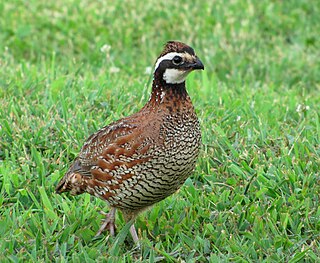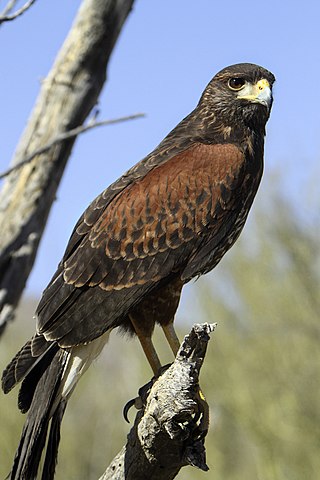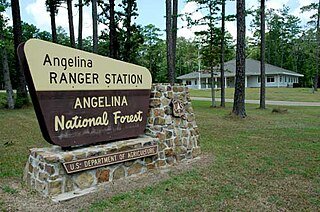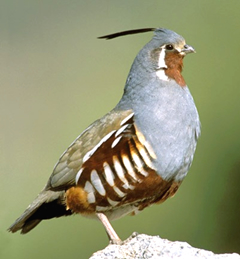Related Research Articles

The northern bobwhite, also known as the Virginia quail or bobwhite quail, is a ground-dwelling bird native to Canada, the United States, Mexico, and Cuba, with introduced populations elsewhere in the Caribbean, Europe, and Asia. It is a member of the group of species known as New World quail (Odontophoridae). They were initially placed with the Old World quail in the pheasant family (Phasianidae), but are not particularly closely related. The name "bobwhite" is an onomatopoeic derivation from its characteristic whistling call. Despite its secretive nature, the northern bobwhite is one of the most familiar quails in eastern North America, because it is frequently the only quail in its range. Habitat degradation has contributed to the northern bobwhite population in eastern North America declining by roughly 85% from 1966 to 2014. This population decline is apparently range-wide and continuing.

Quail is a collective name for several genera of mid-sized birds generally placed in the order Galliformes. The collective noun for a group of quail is a flock, covey, or bevy.

Hunting is the human practice of seeking, pursuing, capturing, and killing wildlife or feral animals. The most common reasons for humans to hunt are to obtain the animal's body for meat and useful animal products, for recreation/taxidermy, although it may also be done for resourceful reasons such as removing predators dangerous to humans or domestic animals, to eliminate pests and nuisance animals that damage crops/livestock/poultry or spread diseases, for trade/tourism, or for ecological conservation against overpopulation and invasive species.

Falconry is the hunting of wild animals in their natural state and habitat by means of a trained bird of prey. Small animals are hunted; squirrels and rabbits often fall prey to these birds. Two traditional terms are used to describe a person involved in falconry: a "falconer" flies a falcon; an "austringer" keeps Goshawks and uses accipiters for hunting. In modern falconry, the red-tailed hawk, Harris's hawk, and the peregrine falcon are some of the more commonly used birds of prey. The practice of hunting with a conditioned falconry bird is also called "hawking" or "gamehawking", although the words hawking and hawker have become used so much to refer to petty traveling traders, that the terms "falconer" and "falconry" now apply to most use of trained birds of prey to catch game. However, many contemporary practitioners still use these words in their original meaning.

The common pheasant is a bird in the pheasant family (Phasianidae). The genus name comes from Latin phasianus, "pheasant". The species name colchicus is Latin for "of Colchis", a country on the Black Sea where pheasants became known to Europeans. Although Phasianus was previously thought to be closely related to the genus Gallus, the genus of junglefowl and domesticated chickens, recent studies show that they are in different subfamilies, having diverged over 20 million years ago.

The New World quail are small birds, that despite their similar appearance and habits to the Old World quail, belong to a different family known as the Odontophoridae. In contrast, the Old World quail are in the Phasianidae family. The geographical range of the New World quail extends from Canada to southern Brazil, and two species, the California quail and the bobwhite quail, have been successfully introduced to New Zealand. The stone partridge and Nahan's partridge, both found in Africa, seem to belong to the family. Species are found across a variety of habitats from tropical rainforest to deserts, although few species are capable of surviving at very low temperatures. There are 34 species divided into 10 genera.

Harris's hawk, formerly known as the bay-winged hawk or dusky hawk, and known in Latin America as the peuco, is a medium-large bird of prey that breeds from the southwestern United States south to Chile, central Argentina, and Brazil. This bird is sometimes reported to be at large in Western Europe, especially Britain, but it is a popular species in falconry and these records almost invariably all refer to escapes from captivity.

The aplomado falcon is a medium-sized falcon of the Americas. The species' largest continuous range is in South America, but not in the deep interior Amazon Basin. It was long known as Falco fusco-coerulescens or Falco fuscocaerulescens, but these names are now believed to refer to the bat falcon. Its resemblance in shape to the hobbies accounts for its old name orange-chested hobby. Aplomado is an unusual Spanish word for "lead-colored", referring to the blue-grey areas of the plumage – an approximate English translation would be "plumbeous falcon". Spanish names for the species include halcón aplomado and halcón fajado ; in Brazil it is known as falcão-de-coleira.

Angelina National Forest is a United States National Forest, one of four located in the piney woods region of Texas. The 153,180-acre (619.9 km2) Angelina National Forest is located in East Texas in parts of San Augustine, Angelina, Jasper and Nacogdoches counties. It is managed together with the three other National Forests in Texas from Forest Service offices in Lufkin, Texas. There are local district offices located in Zavalla. The forest lies in the Neches River Basin and on the north and south shores of Sam Rayburn Reservoir. Longleaf pine is the predominant cover type in the southern portion of the forest, while loblolly and shortleaf pine are dominant species in the northern portion and abundant throughout.
Upland hunting is an American term for a form of bird hunting (fowling) in which the hunter pursues upland birds including quail, pheasant, grouse, woodcock, prairie chicken, chukar, grey partridge, and other landfowls. Unlike aquatic and semiaquatic bird species, upland birds are terrestrial and tend to be found strictly on the dry lands above the high mark of waterbodies, often hidden in heavy groundcover, so hunters generally employ the use of gun dogs to locate, expose and retrieve game. The average group consists of 2-4 hunters with 1-2 dogs.

The scaled quail, also commonly called blue quail or cottontop, is a species of the New World quail family. It is a bluish gray bird found in the arid regions of the Southwestern United States to Central Mexico. This species is an early offshoot of the genus Callipepla, diverging in the Pliocene.

The mountain quail is a small ground-dwelling bird in the New World quail family. This species is the only one in the genus Oreortyx, which is sometimes included in Callipepla. This is not appropriate, however, as the mountain quail's ancestors diverged from other New World quails earlier than the bobwhites, no later than 6 mya.

The white-winged dove is a dove whose native range extends from the Southwestern United States through Mexico, Central America, and the Caribbean. They are large for doves, and can be distinguished from similar doves by the distinctive white edge on their wings. They have a blue eyering, and red eyes. The plumage is brownish-gray to gray. Juveniles are duller in color, and have brown eyes. The call is likened to English phrase "who cooks for you". There are three subspecies. It was first described by George Edwards in 1743, and given its binomial name by Linnaeus in 1756. It was moved into the genus Zenaida in 1838.

The blue-headed quail dove, or blue-headed partridge-dove, is a species of bird in the pigeon and dove family Columbidae. It is monotypic within the subfamily Starnoenadinae and genus Starnoenas.
A quail hunting plantation is a large tract of land typically with a natural wooded and grass habitat for the purpose of recreational hunting of bobwhite quail.

Pheasants Forever, Inc. (PF), a 501(c)(3) non-profit conservation organization, is dedicated to conserving wildlife habitat suitable for pheasants. Formed in 1982 as a response to the continuing decline of upland wildlife and habitat throughout the United States, Pheasants Forever, and its quail conservation division, Quail Forever, have a combined membership of approximately 150,000 throughout North America.

A professional hunter is a person who hunts and/or manages game by profession. Some professional hunters work in the private sector or for government agencies and manage species that are considered overabundant, others are self-employed and make a living by selling hides and meat, while still others guide clients on big-game hunts.

Carlos Avery Game Farm is a complex of 11 buildings at the Carlos Avery Wildlife Management Area in Minnesota, United States, which is listed on the National Register of Historic Places (NRHP). The buildings are the administrative center for the wildlife management area, which extends across a large part of Anoka and Chisago counties, as well as for a number of other Minnesota Department of Natural Resources properties in the area. The nomination for the NRHP noted that when it opened in 1937, it was one of the largest and best-equipped game farms in the nation, as well as one of the first large-scale wildlife management efforts in Minnesota.

The fauna of Louisiana is characterized by the region's low swamplands, bayous, creeks, woodlands, coastal marshlands and beaches, and barrier islands covering an estimated 20,000 square miles, corresponding to 40 percent of Louisiana's total land area. Southern Louisiana contains up to fifty percent of the wetlands found in the Continental United States, made up of countless bayous and creeks.

Herbert L. Stoddard was an American naturalist, conservationist, forester, wildlife biologist, ecologist, ornithologist, taxidermist, and author. In the 20th century he earned a reputation for being one of the American Southeast's most prominent conservationists and a pioneering forest ecologist. He is most well known for his seminal book, The Bobwhite Quail: Its habits, preservation, and increase (1931). He is also widely credited with advocating for the practice of prescribed fire as a tool for wildlife management. He was married to Ada Wechselberg, with whom he had one son, Herbert "Sonny" L. Stoddard Jr.
References
- 1 2 3 Huggler, Tom (1987). Quail Hunting in America: Tactics for Finding and Taking Bobwhite, Valley, Gambel, Mountain, Scaled, and Mearn's Quail by Season and Habitat. Stackpole Books. ISBN 9780786473656 . Retrieved 21 January 2016.
- ↑ Roskelley, Fenton (23 December 1961), "Many Area Hunters Shy Clear of Quail Hunting", Spokane Daily Chronicle, p. 70, retrieved 21 January 2016